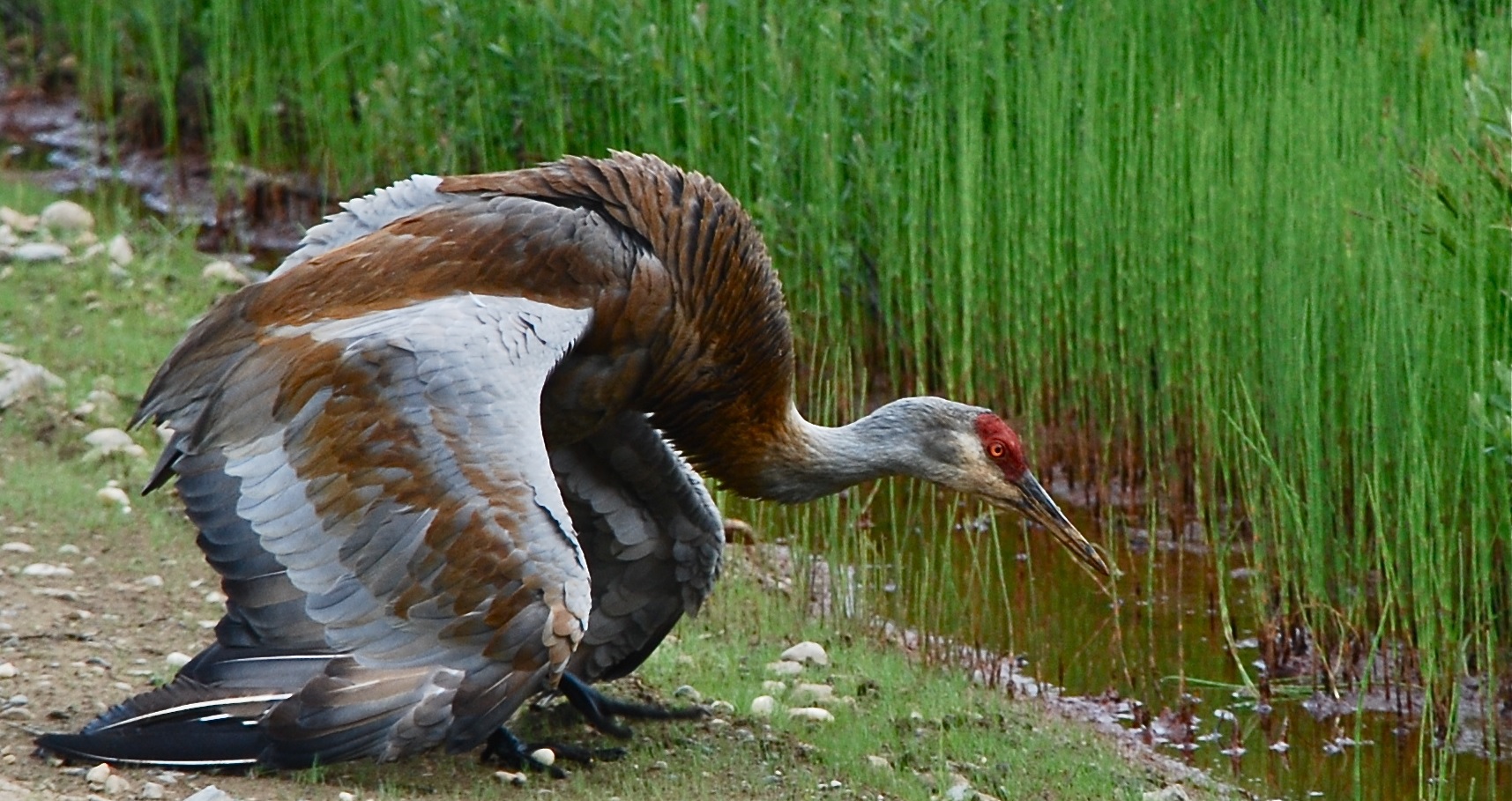
Sandhill Crane Program
2025 BirdReturns-Sandhill Crane Program- Applications NOW CLOSED!
BirdReturns has been working with farmers and landowners for over 10 years to provide habitat for migratory shorebirds, cranes, waterfowl, and other waterbirds. This year, The Migratory Bird Conservation Partnership (MBCP), with funding and support from the California Department of Fish and Wildlife, will be using the BirdReturns Program to provide needed wintering habitat in the Sacramento Valley and Delta for the Greater Sandhill Crane, a California threatened subspecies. Habitat provided through this program will also benefit a wide diversity of other waterbird species including waterfowl, shorebirds, and other wading birds.
2025 BirdReturns-Sandhill Crane Program
The objective of the Sandhill Crane Program is to incentivize farmers to create new crane habitat to increase the resilience of the Central Valley’s population. Our goal is to complement existing habitat by providing additional foraging and roosting habitat. Individual growers may provide either foraging sites or roosting sites, or both in combination.
Roosting sites provide sanctuary habitat for cranes and other waterbirds to congregate and spend the night safe from predators. Fields must be unhunted and flooded from 3-9 inches in depth for at least eight weeks between September 29 and December 31, 2025.
Foraging sites provide locations for cranes to feed near their night roosts. These sites must be harvested grain fields that are left untilled and initially unflooded to maximize the amount of food for the birds.
On some fields, social attraction techniques that involve the use of decoys and broadcasting of crane vocalizations will be used to attract cranes. At these sites, access for setup and monitoring will be necessary. Participation in the social attraction study is optional.
To apply for the Sandhill Crane Winter Program, farmers must submit an application that includes proposed acreage for foraging and/or roosting habitat, start and end dates, and attached maps that show all proposed fields. Farmers enrolled in the program will be paid a fixed rate of $95 an acre for both habitat types.
Further program details are provided below.
Check us out on the latest episode of “Thoughts on Rice: A UCCE Podcast” to hear more about the 2025 BirdReturns-Sandhill Crane Program!
Program Details
Application Period (CLOSED)
- July 25-August 17, 2025 @11:59pm
- Notices of awards and rejections will be issued on or before September 19, 2025.
Geography
- Sacramento Valley and Sacramento-San Joaquin Delta—the primary wintering area of the Greater Sandhill Crane subspecies.
Timing
- Appropriate roosting and/or foraging habitats must be maintained for a period of at least eight weeks between September 29 and December 31, 2025
- Applicants select the enrollment window that works best for them, choosing a Monday start date.
- The final possible start date for the Fall 2025 program will be November 3, 2025.
- Maintaining enrolled habitat for longer than eight weeks is highly encouraged but not required.
- On applications to provide both foraging and roosting habitat, the dates of each habitat type must be the same.
Appropriate Field Types and Sizes
Participants may provide roost habitat (30-acre minimum, 200-acre maximum), forage habitat (50-acre minimum, 500-acre maximum) or a combination of both (habitat complexes) up to 500 acres total. Participants may submit as many bids as they would like, up to 500 acres each. Sites with less hunting pressure are preferred.
Habitat minimums may be met by combining multiple fields as long as they are contiguous. Intervening levees are acceptable. Required conditions for each of the habitat types are detailed below.
Field Requirements
| Roosting Habitat | > Post-harvest or fallow agricultural fields that are at least 30 acres and not larger than 200 acres. > Fields must have reliable access to water for flooding maintenance. > Fields must have a minimum width of 100 meters without continuous bands of large trees along the edge. > Fields without leftover grains are preferred so that leftover grains in your field are not tilled under and are therefore available as food for wintering birds. |
| Foraging Habitat | > Unflooded harvested rice, corn (but not silage corn), or other grain fields (e.g., barley, wheat, oats, etc.) totaling at least 50 acres. If foraging habitat is included in a bid with roosting habitat, then it must be of equal or greater acreage. |
Field Management
| Roosting Habitat | > Fields must be open (no trees or vines) with minimal standing stubble or other vegetation. Incorporation of crop residue or weeds may be needed. > Fields must be fully flooded by the program start date and maintained to shallow depths (3-9”) for at least eight weeks between September 29–December 31, 2025. A two-week gradual drawdown period following the eight-week flooding period is highly encouraged. > In sloping fields, the shallow end may be less than 3”, and the deeper end greater than 9”. Flood management should be done to maximize the desired depth range (3-9”) across the field. |
| Foraging Habitat | > Corn: Harvested and chopped (or mulched) with no tillage (disking/chiseling) before the enrollment end date. Use of a roller to put crop residue in contact with the soil to facilitate decomposition is permitted. > Rice: Conventional harvest (no stripper header), with no tillage (disking/chiseling) before the enrollment end date. Stubble may be left standing or chopped. Use of a roller to put crop residue in contact with the soil is permitted. > Other cover types should be managed similarly. > Forage habitat must be maintained for at least eight weeks. Beginning the sixth (6th) week of enrollment, forage fields may begin a slow flood up but must remain at a maximum depth of two (2) inches or less until the end of the enrollment period (the eighth week). This practice is optional and not a requirement of the program. |
Ineligible Fields
- Fields enrolled in any annual incentive program (i.e., NRCS EQIP) that provides payment to conduct flooding during any overlapping time period. Enrollments may be staggered back-to-back in time.
- Fields located within five miles of major airports, including Travis AFB, Beale AFB, and Sacramento International.
- Fields where any hunting occurs. No hunting is allowable on enrolled roost fields or fields directly adjacent to the enrolled roost fields.
- Roost fields with trees along their borders are excluded. Foraging fields may have some trees on their edges, but fewer trees are preferred.
Payment Rates
PROGRAM BUDGET: $830,000
SANDHILL CRANE HABITAT PROGRAM ACREAGE GOAL: 10,000 acres
PAYMENT RATE: $95 per acre
Application Ranking and Scoring Processes
All bids will be ranked and scored by representatives from the Migratory Bird Conservation Partnership and the California Department of Fish and Wildlife. The selection committee will assess bids according to standardized methods, using the best available science and tools to predict the habitat value of each bid. Fields will be given a score based on position in the landscape relative to historical roost sites, land cover, surface water availability, and timing. Previously enrolled fields that maintained good compliance may factor positively in scoring. New applicants are also encouraged to apply!
Highest priority will go to bids in regions of known historic use by cranes, as informed by roosting maps and scientific literature. Within these regions, funds will be prioritized in the following order:
- Habitat complexes containing both roosting and foraging habitat
- Foraging habitat
- Roosting habitat
The highest-scoring bids will be selected until the acreage goal is met and/or the budget is spent. If an applicant submits multiple bids on a property, initially only the highest scoring bid from each property will be accepted. Once all properties have been considered, if the acreage goal has not been met and budget remains, additional bids from each property will be considered in ranked order. We reserve the right to reject any bids that are outside of the program requirements, intent, or team capacity. Feel free to contact us if you would like to discuss what type of habitat (roosting and/or foraging) is most desirable for your specific location, or if you would like additional explanation about the scoring criteria.
Why The Sandhill Crane Program Is Important?
Worldwide, cranes are one of the most imperiled groups of birds. In recent years, wintering Sandhill Cranes populations in California appear to have declined due to the loss of flooded habitats which they depend upon for roosting, and reductions in small grain agriculture which provides their main food source. The conversion of wildlife-friendly seasonal field crops like corn, and rice, to more permanent crops such as orchards and vines has directly eliminated large areas of habitat for this iconic Central Valley species. Compounding this problem is the fact that many sandhill cranes return to the same sites year after year. If historic habitats are lost, they may struggle to find new, suitable sites.
Fortunately, however, Sandhill Cranes respond well to the implementation of simple management actions that are easy to implement for many farmers. All that is needed is to create flooded areas for roosting flocks, and nearby foraging habitats in suitable harvested agricultural fields. Our program is designed to achieve this by providing compensation to farmers who are interested and willing to manage their fields in this way.
By increasing the number of potential roost sites and using social attraction techniques to entice cranes to use them, we can offset the losses of suitable wintering habitat that is currently occurring in this region and ensure that these iconic birds have the resources they need to thrive.
Maintaining a mosaic of wetlands and well-managed wildlife-friendly croplands will allow this region to continue to support these birds while simultaneously benefiting other wildlife and the regional economy.


The BirdReturns-Late Summer Farmlands Habitat Program is managed by the Migratory Bird Conservation Partnership (The Nature Conservancy, Audubon California, and Point Blue Conservation Science), in partnership with the Delta Conservancy, and the program funder, the California Department of Fish and Wildlife.
Questions? Contact Us!
Billy Abbott
530-228-1862
william.abbott@tnc.org
Bekka Rosenkrantz
916-243-0428
bekka.rosenkrantz@tnc.org




